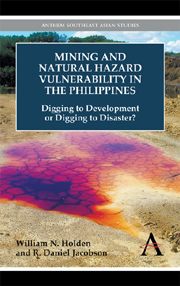 Mining and Natural Hazard Vulnerability in the Philippines
Mining and Natural Hazard Vulnerability in the Philippines Book contents
- Frontmatter
- Contents
- Acknowledgments
- List of Tables and Figures
- List of Acronyms
- Introduction
- Chapter One Mining in the Philippines
- Chapter Two Government Efforts to Encourage Mining
- Chapter Three Environmental Effects of Mining
- Chapter Four Mining amid Natural Hazards
- Chapter Five Technocratic Responses to the Risks
- Chapter Six Risk Society in the Philippines
- Chapter Seven Mining as a Flawed Development Paradigm
- Chapter Eight Is Another World Possible?
- Conclusion
- Bibliography
- Index
Chapter Four - Mining amid Natural Hazards
Published online by Cambridge University Press: 05 May 2012
- Frontmatter
- Contents
- Acknowledgments
- List of Tables and Figures
- List of Acronyms
- Introduction
- Chapter One Mining in the Philippines
- Chapter Two Government Efforts to Encourage Mining
- Chapter Three Environmental Effects of Mining
- Chapter Four Mining amid Natural Hazards
- Chapter Five Technocratic Responses to the Risks
- Chapter Six Risk Society in the Philippines
- Chapter Seven Mining as a Flawed Development Paradigm
- Chapter Eight Is Another World Possible?
- Conclusion
- Bibliography
- Index
Summary
The Philippines: Spaces of Hazard
Natural hazards are those atmospheric, hydrologic, geologic and other naturally occurring physical phenomena that have the potential to harm humans (Punongbayan 1994). An extensive body of literature exists documenting the vulnerability of the Philippines to natural hazards (Bankoff 1999, 2003a, 2003b; Bankoff and Hilhorst 2009; Delica 1993; Holden 2011; Luna 2001; Yumul et al. 2011).
Typhoons: One of the World's Most Powerful Atmospheric Phenomena
Typhoons: Tropical cyclones in the Western Pacific
Typhoon, originating from the Chinese tai (strong) and fung (wind), is the term used to describe a tropical cyclone in the Western Pacific Ocean (Bankoff 2003a). A typhoon is one of the world's most powerful atmospheric phenomena with a fully developed typhoon releasing the energy equivalent to many Hiroshima-sized atomic bombs (Wisner et al. 2004). Typhoons develop in the northern hemisphere during the months of July to November in an area just north of the equator (Bankoff 2003a; Wisner et al. 2004). They develop when strong clusters of thunderstorms drift over warm ocean waters having a temperature of at least 26.5 degrees Celsius. Warm air from the thunderstorms combines with the warm air from the ocean surface and begins rising; as this air rises there will be a reduction in air pressure on the surface of the ocean. As these clusters of thunderstorms consolidate into one large storm, trade winds blowing in opposite directions will cause the storm to begin spinning in a counter clockwise direction, while rising warm air causes air pressure to decrease at higher altitudes (Gonzalez 1994; Van Aalst 2006).
- Type
- Chapter
- Information
- Mining and Natural Hazard Vulnerability in the PhilippinesDigging to Development or Digging to Disaster?, pp. 77 - 120Publisher: Anthem PressPrint publication year: 2012
